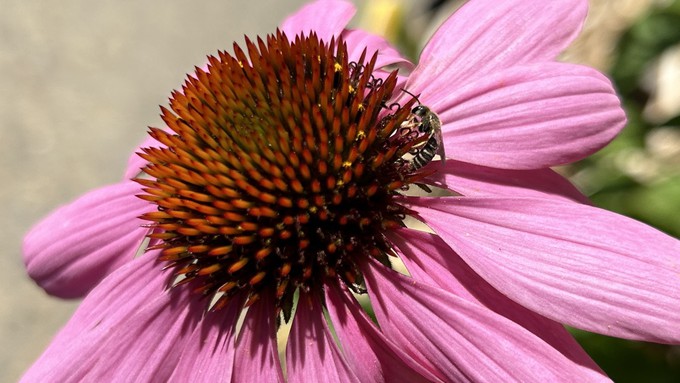
Pollinator Week celebrates and supports these crucial workers

Purple coneflowers produce both pollen and nectar, making them a favorite with bees, such as this furrow bee, part of the species of sweat bees. Kathy Morrison
What's your favorite pollinator?
If you said "bee," here's the perfect time to get specific. It's International Pollinator Week, through Sunday, celebrating and supporting pollinator health.
Honeybees are pollinators, of course, but they're not native to the Uniated States. California has more than 1,600 identified bee species -- all but a handful are native. Then of course there are flies, wasps, butterflies, bats, beetles, moths and birds that do the important work of pollinating plants and crops.
I'm fond of the little green sweat bees, but don't see them as often as I do the big lumbering carpenter bees that frequent my 'Hot Lips' salvia plant.
Whatever your favorite, pollinators are important to us. They provide one of every three bites of food we eat, according to the Pollinator Partnership, but they are threatened by urban growth, climate change and loss of habitat.
Here is the Partnership's guide for helping pollinators:
-- Plant a range of flowering plants, especially natives. (Pollinators need food through the seasons, so successful pollinator gardens always have something blooming.)
-- Reduce or eliminate your contribution to the use of pesticides. (Psst: Eliminate it! Pesticides too easily hurt the good bugs, too.)
-- Reach out to others -- inform and inspire! (Get the neighbors to plant for pollinators, too.)
-- Support local bees and beekeepers.
-- Conserve all of our resources. Use less and reduce your impact. (That organic waste bucket is being used, right?)
-- Support the work of groups promoting science-based practical efforts for pollinators.
For more information and inspiration, explore the resources at the UC Davis Bee Haven website, the Insect Connect website (part of the University of California Division of Agriculture and Natural Resources) or the Pollinator Partnership at pollinator.org
Comments
0 comments have been posted.Sacramento Digs Gardening to your inbox.
Food in My Back Yard Series
May 6: Maintain soil moisture with mulch for garden success
April 29: What's (already) wrong with my tomato plants?
April 22: Should you stock up on fertilizer? (Yes!)
April 15: Grow culinary herbs in containers
April 8: When to plant summer vegetables
April 1: Don't be fooled by these garden myths
March 25: Fertilizer tips: How to 'feed' your vegetables for healthy growth
March 18: Time to give vegetable seedlings some more space
March 11: Ways to win the fight against weeds
March 4: Potatoes from the garden
Feb. 25: Plant a fruit tree now -- for later
Feb. 18: How to squeeze more food into less space
Feb. 11: When to plant? Consider staggering your transplants
Feb. 4: Starting in seed starting
Sites We Like
Garden Checklist for week of May 4
Enjoy this spring weather – and get gardening!
* Plant, plant, plant! It’s prime planting season in the Sacramento area. Time to set out those tomato transplants along with peppers and eggplants. Pinch off any flowers on new transplants to make them concentrate on establishing roots instead of setting premature fruit.
* Direct-seed melons, cucumbers, summer squash, corn, radishes, pumpkins and annual herbs such as basil.
* Harvest cabbage, lettuce, peas and green onions.
* In the flower garden, direct-seed sunflowers, cosmos, salvia, zinnias, marigolds, celosia and asters. (You also can transplant seedlings for many of the same flowers.)
* Plant dahlia tubers. Other perennials to set out include verbena, coreopsis, coneflower and astilbe.
* Transplant petunias, marigolds and perennial flowers such as astilbe, columbine, coneflowers, coreopsis, dahlias, rudbeckia and verbena.
* Keep an eye out for slugs, snails, earwigs and aphids that want to dine on tender new growth.
* Feed summer bloomers with a balanced fertilizer.
* For continued bloom, cut off spent flowers on roses as well as other flowering plants.
* Add mulch to the garden to maintain moisture. Mulch also cuts down on weeds. But don’t let it mound around the stems or trunks of trees or shrubs. Leave about a 6-inch to 1-foot circle to avoid crown rot or other problems.